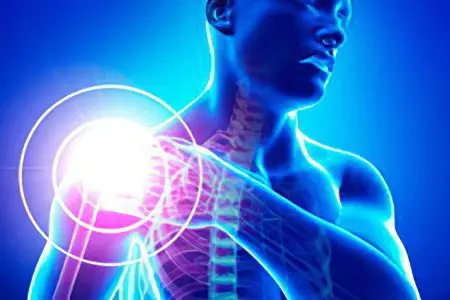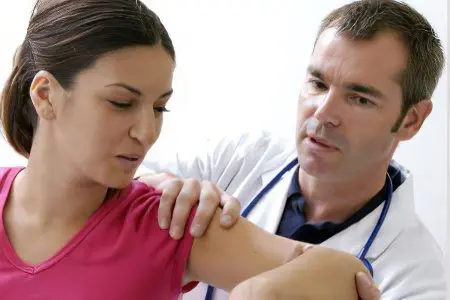Shoulder pain is a symptom of a number of different conditions. It may be associated with changes in bone and muscle tissue, as well as tendons, or it may indicate an infection in the body.
Causes of shoulder pain
Often the cause of the pain is excessive physical activity. For example, long-term exercises with a barbell in the gym, carrying weights. A sports injury is also possible (dislocation of the shoulder, sprain or rupture of ligaments, damage to muscle tissue).
People over the age of 50 often suffer from arthrosis, which causes ossification of cartilage tissue, which makes itself felt with an unpleasant pain symptom and decreased mobility.
Infectious diseases such as chlamydia, candidiasis, tuberculosis and some others can also cause problems with the shoulder joint.
Any inflammatory processes directly in the joint and in the tissues surrounding it will certainly result in long-term and constant discomfort in the shoulder area.
Diagnostics

To correctly determine the real cause of the problem, it is necessary to specify the nature of the pain in the shoulder joint:
Pain in the upper part of the shoulder, radiating to the arm (right up to the hand), may indicate problems with the spine (osteochondrosis, hernia). As a rule, the character is aching, permanent. Increases with neck movement. There may be swelling.
Temporary pain may be associated with inflammation of the tendons or damage to the rotator cuff. As a rule, the cause is excessive stress on the joint: for example, cutting firewood, painting the ceiling, playing golf, or doing other repetitive activities for a long time.
Intense and constant pain in the shoulder joint, which manifests itself when raising the arm, may be the result of salt deposits. They accumulate gradually, and appear – suddenly. Similar symptoms occur in arthritis and arthrosis.
With a disease such as periarthrosis, the nature of the pain can change. It makes it difficult to move the hands during the day (during normal activity), often worsens at night (at rest).
A separate issue is sports injuries. They make themselves felt with impulsive pain that haunts the performance of certain movements (for example, bench press). As a rule, problems with tendons are manifested. To determine which tendons are affected, an increase in the intensity of the pain syndrome when certain hand movements are made will help. Typical diseases are bursitis, tendinitis and tendobursitis. In this case, not only tendons can suffer, but also individual muscles or a joint bag.
As a result of a fall or making sudden movements, a dislocation can occur, characterized by severe ongoing pain and swelling. It is very important in this case to undergo an examination (X-ray, examination). If the tissues do not heal properly (fix in the wrong position), then shoulder pain runs the risk of becoming lifelong and untreated.
Muscle stiffness (aka capsulitis) usually develops gradually. The disease becomes noticeable when it becomes difficult to take the arm back or to the side.
Infectious diseases and diseases of the internal organs are characterized by aching, sometimes acute throbbing pain, which spreads to the entire shoulder area, often affects the scapular area and radiates to the arm.
Shoulder pain treatment

If the pain in the shoulder was caused by an injury (fracture, dislocation), first of all, a cold compress should be applied to the affected area. It will help stop internal hemorrhage (as a result, it will reduce swelling), and also alleviate discomfort. In other cases, it is worth paying attention to pharmacological preparations.
To relieve pain in the joint, which arose as a result of overexertion, it is enough to use special means for external influence (ointments or gels) – non-steroidal anti-inflammatory drugs. They have analgesic as well as anti-inflammatory effects, and are usually sold without a prescription.
At home, it is more convenient to use gels – they are absorbed faster, do not leave a greasy film on the skin, do not clog pores and penetrate deep into the tissues. As for active active substances, diclofenac sodium, capsacin, menthol, nimesulide can be included in complex medicines.
When using ointments, creams or gels, it should be remembered that they should not be applied to damaged areas of the skin and mucous membranes. It is also not recommended to apply such products under an airtight bandage or combine them with exposure to warming objects (heating pad, elastic bandage, compress) in order to avoid burns. If an allergic reaction occurs (burning, itching, severe reddening of the skin, swelling, etc.), you must immediately wash off the drug with warm water without soap.
If the action of local remedies is not enough to solve the problem, complex solutions may be needed – tablets or drops.
It is better to select drugs for oral administration together with your doctor, taking into account the general condition of the body and the presence of certain diseases, including possible allergic reactions.
To determine the exact diagnosis and prescribe effective treatment, you should consult an orthopedic doctor. If the pain was the result of physical exertion, it would be useful to consult an orthopedist experienced in the diagnosis and treatment of sports injuries, or a trauma surgeon.









